Day 1
For the last holiday season my wife and i had a shorter than usual number of days off, so we decided to visit a place we haven't been to and one that we could see quite a bit in a shorter time.
Burma !!! or currently known as Myanmar .
After a shortish flight we arrived in Rangoon .
For the whole trip we will be guided and driven everywhere .
Madam is here.
If its just the guys things will be a lot lot lot less fancy. :-)
Sights in the city.
Vietnam has the same sized chairs .
After checking in we start our tour .
Kandawgyi Lake , formerly Royal Lake), is one of two major lakes in Yangon, Burma (Myanmar). Located east of the Shwedagon Pagoda, the lake is artificial; water from Inya Lake is channelled through a series of pipes to Kandawgyi Lake. It was created to provide a clean water supply to the city during the British colonial administration
The Shwedagon Pagoda in the background left .
The Karaweik on the right .
The entrance of the Karaweik.
The barge is a two-storied construction of concrete and stucco, reinforced by iron rods, with a pyatthat-topped roof, two reception halls and a conference room.[2] It houses a buffet restaurant today.
Right out side the Karaweik .
From there we walk along the lake...
Views...
The Royal barge .
Utopia Tower is a giant pile of artificial rocks housing bars, karaoke, a massage parlour and, on the 5th floor, a viewing deck.
Memories .
The place is hot ,but not at all humid .
That is impressive .
The boardwalk along the lake.
It is in terrible condition ,and you really have to watch where you step .
The views make up for it though .
Our guide and car .
Now we visit here .
The entrance .
Lots of people .
Almost at the main square .
Many side pagodas...
And nooks.
Highly decorated everywhere .
Many many small temples.
And the main pagoda.
The Shwedagon Pagoda, officially named Shwedagon Zedi Daw and also known as the Great Dagon Pagoda and the Golden Pagoda, is a gilded stupa located in Yangon, Myanmar. The 99-metre-tall (325 ft)[1] pagoda is situated on Singuttara Hill, to the west of Kandawgyi Lake, and dominates the Yangon skyline.
Gilded indeed .
Shwedagon Pagoda is the most sacred Buddhist pagoda in Myanmar, as it is believed to contain relics of the four previous Buddhas of the present kalpa. These relics include the staff of Kakusandha, the water filter of Koṇāgamana, a piece of the robe of Kassapa, and eight strands of hair from the head of Gautama.
Historians and archaeologists maintain that the pagoda was built by the Mon people between the 6th and 10th centuries CE.[2] However, according to legend, the Shwedagon Pagoda was constructed more than 2,600 years ago, which would make it the oldest Buddhist stupa in the world.[3] According to tradition, Taphussa and Bhallika — two merchant brothers from the north of Singuttara Hill what is currently Yangon met the Lord Gautama Buddha during his lifetime and received eight of the Buddha's hairs. The brothers returned to Burma and, with the help of the local ruler, King Okkalapa, found Singuttara Hill, where relics of other Buddhas preceding Gautama Buddha had been enshrined.
The base of the stupa is made of bricks covered with gold plates. Above the base are terraces that only monks and other males can access. Next is the bell-shaped part of the stupa. Above that is the turban, then the inverted almsbowl, inverted and upright lotus petals, the banana bud and then the umbrella crown
The crown is tipped with 5,448 diamonds and 2,317 rubies. Immediately before the diamond bud is a flag-shaped vane. The very top—the diamond bud—is tipped with a 76 carat (15 g) diamond
Devotees .
The main pagoda is surrounded by these small temples .
The gold seen on the stupa is made of genuine gold plates, covering the brick structure and attached by traditional rivets .People all over the country, as well as monarchs in its history, have donated gold to the pagoda to maintain it. The practice continues to this day after being started in the 15th century by the Queen Shin Sawbu
There are four entrances, each leading up a flight of steps to the platform on Singuttara Hill. A pair of giant leogryphs guards each entrance.
Hard to get a photo with no one else in it .
Like so .
The bell weighs about 23-25 tons and measures 2.13 metres (7.0 ft) high, 2.01 metres (6.6 ft) wide at the mouth and 0.305 metres (1.00 ft) thick
Statues everywhere .
Locals .
A really huge pagoda.
The gems right at the top .
And the huge diamond .
What it looked like many years ago .
What it looks like now .
A bit of south indian influence .
We will continue the rest of Yangoon at the end of our tour.
Time for some dinner and zzzzz
Day 2
Early in the morning we head to the airport again...
Local airline .
Hazy and dry landscape .
Not long after we reach Mandalay .
A different car and driver and we're off .
The airport is quite a way out of the city
Paddy fields and pagodas.
Oxen carts .
3rd world in all its glory .
Our ride stops here first...
Local ladies and the all important cold cream.
We get on to those boats...
Cross the Irrawaddy river.
And are headed thataway .
Home made boats .
Soon we reach .
Peddlers .
A common sight here .
If you want the trots...
This is our destination .
Inwa or Ava located in Mandalay Region, Burma (Myanmar), is an ancient imperial capital of successive Burmese kingdoms from the 14th to 19th centuries.
And this is how we get there .
Dobbie ?
Our ride :-)
Our guide and coachman .
This girl tried to sell us stuff.
We refused , more later ..
And we're off .
Lots of carts for the tourist .
Myanmar is really not developed .
So we got the authentic experience .
In a few years time as the country opens up all this will change .
Future Starbucks site .
Back to her.
She followed our horse cart for miles .
Many others were doing the same to other tourist .
All for one USD .
We don't mind spending ,but will not be forced to .
Ancient palace walls .
A better level of house .
This is the real countryside .
Inwa was the capital of Burma for nearly 360 years, on five separate occasions, from 1365 to 1842. So identified as the seat of power in Burma that Inwa (as the Kingdom of Ava, or the Court of Ava) was the name by which Burma was known to Europeans down to the 19th century.
Ancient Stupas .
Lawka Tharahpu Pagoda
Thats the moat surrounding the ancient city .
Local industry .
The city walls .
A more common type of house .
Hard sell .
Surrounding views .
Our first stop .
Here .
The Bagaya Monastery located in Inwa, Mandalay Region, Burma (Myanmar) is a Buddhist monastery built on the southwest of Inwa Palace.
The Bagaya Monastery which consists of the seven-tiered spire has Dhanu hall and Bhawga hall. It also has eight stairways made up of bricks.[5] The monastery, which was built with 267 gigantic teak wood posts, has a structure of great dimensions: 188 feet (57 m) high in length and 103 feet (31 m) in width
This weather-worn but magnificent monastery stands in the middle of wide paddy fields, with palms, banana trees and thorny green bushes clustered in profusion around its shady base.
The monastery is decorated with splendid Burmese architectural works such as carvings, floral arabesques, the ornamentation with curved figurines and the reliefs of birds and animals as well as small pillars decorated on the wall, the artistic works of Inwa Era.
A great fire broke out on 15 April 1821. Many important buildings, including the Bagaya Monastery, were burnt in the fire. The government tried to reconstruct in 1992 and built the new brick building in the place of the old monastery for the use of Buddha image and Pitaka scriptures. It was recorded that the monastery was constructed based on the model of the old monastery .
Ornate carvings .
Local teak wood .
Nice carved doors.
The Bagaya Monastery which consists of the seven-tiered spire has Dhanu hall and Bhawga hall.
The monastery is decorated with splendid Burmese architectural works such as carvings, floral arabesques, the ornamentation with curved figurines and the reliefs of birds and animals as well as small pillars decorated on the wall, the artistic works of Inwa Era .
A young monk attending classes .
The teacher :-P
The monastery, which was built with 267 gigantic teak wood posts, has a structure of great dimensions: 188 feet (57 m) high in length and 103 feet (31 m) in width .
The central altar.
57m high ?
Nope. I doubt it... wiki is wrong .
Nice inner doors .
Local residents.....they fly at night .
In every Burmese site ,footwear AND socks are not allowed .
It can drive you ''bat shit''.....get it :-p :-p
The main entrance gate .
Quite big .
And Dobby goes on...
These are the main tourist roads.......double track.
This was the Royal swimming pool . Cool huh .
And we reach our destination .
The site of the deserted Palace of Ava is now marked by just a solitary 27m high watchtower, Nanmyin.
It is an example of early 19th century Burmese architecture built by King Bagyidaw. The upper portion was shattered by the 1838 earthquake and the rest has taken on a precarious tilt - it's known as the 'Leaning Tower of Innwa' -John P Bunbury, Australia
In the past tourist could climb up .
After another earthquake caused more damage ,it was fenced off.
Tilted to one side .
Back on the MAIN road .....
Yup, i kid you not.
Bunny and her bunny .
And Dobby .
Our next destination .
Thataway .
Memories .
And Myanmar does not have lions ???
Two large Chinthes, the Burmese mythological lions, protect the entrance, as is the case with most Burmese temples .
The Maha Aung Mye Bonzan Monastery is a fine example of Burmese monastery architecture during the Konbaung dynasty. The monastery, also known as the Brick Monastery is a well preserved building in ochre color. The very ornate structure is decorated with intricate stuccoed sculptures.
The Maha Aung Mye Bonzan Monastery was built by Queen Me Nu, wife of King Bagyidaw of the Konbaung dynasty in 1818 as the residence of the Royal Abbott. It is also known as Me Nu Oak Kyaung which translates to Me Nu’s brick monastery.
On the grounds of the monastery are a number of white stupas in different sizes topped with golden hti’s, a spire ornament in the shape of an umbrella.
The earthquake of 1838, damaged it, and in 1873, it was restored by Sinbyumashin, Queen of Mindon, and a daughter of Nanmadaw Me Nu.
Time to go in .
It was also designed as a fortress .
Hence the thick walls .
The main altar .
Hot outside...but very cool inside .
The carvings extend around the monastry .
Views from the top .
When we go back , our slippers follow us into the shower ,daily .
A last look.....
And back to the boat .
Bye Dobby .
After crossing the river ,.....
We stop at a modern monastry .
Quiet
Afternoon siesta for the senior monk .
Lodgings for the novices .
Clock tower in the monastry complex.
A last look...
Then to a new place .
We park and walk...
Shops on the dry river bed
Local handicraft.
This is what we came to see.
U Bein Bridge is a crossing that spans the Taungthaman Lake near Amarapura in Myanmar. The 1.2-kilometre (0.75 mi) bridge was built around 1850 and is believed to be the oldest and longest teakwood bridge in the world .Construction began when the capital of Ava Kingdom moved to Amarapura
Its quite long.
The construction was started in 1849 and finished in 1851. Myanmar construction engineers used traditional methods of scaling and measuring to build the bridge. According to historic books about U Bein Bridge, Myanmar engineers made scale by counting the footsteps.
The bridge was built in curve shape in the middle to resist the assault of wind and water. The main teak posts were hammered into lake bed seven feet deep. The other ends of the posts were shaped conically to make sure that rain water fall down easily. The joints were intertwined.
There are nine passageways in the bridge, where the floors can be lifted to let boats and barges pass. There are altogether 482 spans and the total length of the bridge is 3967 feet or ¾ of a mile.
This is actually very good .
Lunch by the lake .
No humidity at all .
Back on our car...
And the tour continues as we head back to Mandalay .
Temples everywhere .
We are headed up that hill.
Mandalay Hill is a 240 metres (790 ft) hill that is located to the northeast of the city centre of Mandalay in Burma. The city took its name from the hill. Mandalay Hill is known for its abundance of pagodas and monasteries, and has been a major pilgrimage site for Burmese Buddhists for nearly two centuries. At the top of the hill is the Sutaungpyei (literally wish-fulfilling) Pagoda.
Passing the palace moat .
And more temples .
Lots of temples .
The Chinthe is a leogryph (lion-like creature) that is often seen at the entrances of pagodas and temples in Burma, Cambodia, Laos and is related to the Singha in Thailand and the Simha in Sri Lanka as well as to other similar lion statues in other parts of Asia. The chinthe and the simha are featured prominently on the Burmese kyat and the Sri Lankan rupee respectively. The chinthe is almost always depicted in pairs, and serve to protect the pagoda. They typically appear as animals, but are sometimes found with human faces
We work our way up.
We start the ascend...
Huge escalators...thank god .
At the peak.
The Sutaungpyei Pagoda
Really well decorated .
Lots of glass work .
One of the main altars.
And now the view .
The royal palace .
Bunny :-)
Shiny everywhere .
Back to the views .
The Irrawaddy river in the background .
Offerings .
On the other side...the Shan Hills seen in the distance .
The Shan Hills, also known as Shan Highland, is a vast mountainous zone that extends through Yunnan to Myanmar and Thailand. The whole region is made up of numerous mountain ranges separated mostly by narrow valleys as well as a few broader intermontane basins. The ranges in the area are aligned in such a way that they link to the foothills of the Himalayas further to the northwest
Zoom...more stupas .
A very decorated spot in the temple .
Nice huh .
After that experience we head down...
To here .
Kuthodaw Pagoda is a Buddhist stupa, located in Mandalay, Burma (Myanmar), that contains the world's largest book. It lies at the foot of Mandalay Hill and was built during the reign of King Mindon. The stupa itself, which is gilded above its terraces, is 188 feet (57 m) high, and is modelled after the Shwezigon Pagoda at Nyaung-U near Bagan. In the grounds of the pagoda are 729 kyauksa gu or stone-inscription caves, each containing a marble slab inscribed on both sides with a page of text from the Tipitaka, the entire Pali Canon of Theravada Buddhism.
The main entrance .
Construction began in 1860, its hti (umbrella or crown) mounted on 19 July 1862, and the inscriptions were laid open to the public on 4 May 1868. They were arranged in neat rows within three enclosures, 42 in the first, 168 in the middle and 519 in the third. One more stands at the southeast corner of the first enclosure making it 730, and this stone records how it all came into being
Its quite big .
One page !!!
And on the other side .
Now go read all :-P
As we walk some more...
Huge doors .
How the British did what they did in all parts of the world.
After the annexation of Mandalay by the British in 1885, the walled city with Mandalay Palace became Fort Dufferin, and troops were billeted all around Mandalay Hill in the monasteries, temples and pagodas. They became off-limits to the public and Burmese were no longer allowed to visit their religious sites. One revenue surveyor called U Aung Ban then came up with the idea of appealing direct to Queen Victoria since she had promised to respect all religions practised by her subjects. To their amazement and great joy the British queen promptly ordered the withdrawal of all her troops from religious precincts in 1890. This however turned to great sadness when they found that the pagoda had been looted from the hti, left lying on the ground stripped of its bells, gold, silver, diamonds, rubies and other precious stones, down to the Italian marble tiles from its terraces. The zayats lay in utter ruin and the bricks had been used to build a road for the troops. All the brass bells from all the kyauksa gu stupas were gone, 9 on each making it 6570 in total. The gold ink from the letters as well as the sides and top of each marble slab had also disappeared. All the biloos along the corridors had lost their heads, and the marble eyes and claws from the masonry chinthes go
Memories .
A traditional bridal outfit. Very nice of them to let us take a pic .
We approach the center of the temple .
And reach the main stupa .
Overall a very interesting experience .
Time to leave...
A long day...but the tour continues .
Shwenandaw Monastery "Golden Palace Monastery") is a historic Buddhist monastery located near Mandalay Hill, Mandalay Region, Myanmar (formerly Burma).
Shwenandaw Monastery was built in 1878 by King Thibaw Min, who dismantled and relocated the apartment formerly occupied by his father, King Mindon Min, just before Mindon Min's death, at a cost of 120,000 rupees.[1] Thibaw removed the building in 10 October 1878, believing it to be haunted by his father's spirit.[2] The building reconstruction was finished in 31 Oct 1878, dedicated in memory of his father, on a plot adjoining Atumashi Monastery
The building was originally part of the royal palace at Amarapura, before it was moved to Mandalay, where it formed the northern section of the Hmannan (Glass Palace) and part of the king's royal apartments.[2] The building was heavily gilt with gold and adorned with glass mosaic work.
The monastery is known for its teak carvings of Buddhist myths, which adorn its walls and roofs. The monastery is built in the traditional Burmese architectural style. Shwenandaw Monastery is the single remaining major original structure of the original Royal Palace today
Ornate .
We go towards the rear for better lighting .
Dismantled and reassembled here .
Labour is very cheap .
Huge teak pillars .
A common theme and layout.
Gilded though .
Imagine this place at night .
Everything carved has a meaning .
Mostly lost in time .
The old and the new ;-P
A last look...
Before we call it a day...
I wanted to stop here. At the moat surrounding the royal palace.
We did not go into the palace because - The whole magnificent palace complex was destroyed by a fire during World War II. However, the finely built palace walls, the city gates with their crowning wooden pavilions and the surrounding moat still represent an impressive scene of the Mandalay Palace, "Mya-nan-san-kyaw Shwenandaw", which has been rebuilt using forced labor. A model of the Mandalay Palace, Nanmyint-saung and Mandalay Cultural Museum are located inside the Palace grounds.
We were up there .
Now for some rest.
Our hotel lobby :-)
Eat and zzzzzzzzz
Day 3
After breakfast we start our tour .
A local procession.
Downtown Mandalay .
Our car park...
And our boat .
That one...see the route down and the planks up ??
A busy river side operation .
Thats a large floating hotel.
Mandalay Karaweik Mobile Hotel
On our boat...
All this just for the 2 of us .
The route down .
The Irrawaddy river.
We're headed thataway.
Our guide in the traditional sarong/ longyi .
Hot tea with a view .Its actually cold...about 18C
Sights...
During the rains the sand banks are all underwater .
Observe madams choice of seating...in the sun....Cold!!
I've always wanted to sail down the Irrawaddy river. Bucket list- ticked .
Seasonal dwellings for farmers .
Local life.
My bunnies .
Myanmar flag on a bamboo pole. Authentic .
Locally made bamboo chairs.
We're headed there...
We are quite far away...and that is only one third of the intended height.
Its massive .
Sights on the river .
A boat like ours .
A river side village...
Washing clothes...by the river...just like this through the ages .
Finally we reach...
The town called Mingun .
A temple by the river.
Remember the guardian lions...This is just part of it.
That is the rear haunch of the lion. .It would have been enormous .
Imagine..just 1/3 of the intended height .
That is the marble eyeball of the lion .
See the huge cracks. ...earthquake.
The Mingun Pahtodawgyi is an incomplete monument stupa in Mingun, approximately 10 kilometres (6.2 mi) northwest of Mandalay in Sagaing Region in central Myanmar (formerly Burma). The ruins are the remains of a massive construction project begun by King Bodawpaya in 1790 which was intentionally left unfinished
It was not completed, due to an astrologer claiming that, once the temple was finished, the king would die.[1] The completed stupa would have been the largest in the world at 150 metres (490 ft). Huge cracks are visible on the structure from the earthquake of 23 March 1839.[2] Like many large pagodas in Myanmar, a pondaw paya or working model of the stupa can be seen nearby.
By the time the construction project was abandoned, the pagoda had attained a height of 50 meters, one third of the intended height. An earthquake on 23 March 1839 caused huge cracks to appear on the face of the remaining structure.[2] The temple serves more as an attraction than a religious site. However, a small shrine with a Buddha image still serves its purpose as a place of worship and meditation
Its huge !!!!
See the side entrance ?
Next we visit the.....
The Mingun Bel is a bell located in Mingun, Sagaing Region, Myanmar. It is located approximately 11 km (6.8 mi) north of Mandalay on the western bank of the Irrawaddy River. It was the heaviest functioning bell in the world at several times in history.
Huge cast pieces .
Casting of the bell started in 1808 and was finished by 1810. King Bodawpaya (r. 1782–1819) had this gigantic bell cast to go with his huge stupa, Mingun Pahtodawgyi. The bell was said to have been cast on the opposite side of the river and was transported by using two boats, which after crossing the river, proceeded up two specially built canals. The canals were then dammed and the bell was lifted by raising the water level by the addition of earth into the blocked canal. In this way the bell was originally suspended.[4]
The Mingun Bell was knocked off its supports as a result of a large earthquake on 23 March 1839. It was resuspended by the Irrawaddy Flotilla Company in March 1896 using screw jacks and levers
Quasimodo was nowhere so...
The outer diameter of the rim of the bell is 16 feet 3 inches (4.95 m). The height of the bell is 12.0 feet (3.66 m) on the exterior and 11.5 feet (3.51 m) in the interior. The outside circumference at the rim is 50.75 feet (15.469 m). The bell is 6 to 12 inches (15–30 cm) thick and stands 20.7 feet (6.31 m) high from the rim to the top.[3]
The bell is uncracked and in good ringing condition. The bell does not have a clanger but is rung by striking the outer edge
We continue walking...
Past shops and temples...
To this.
The entrance .
The Hsinbyume Pagoda also known as Myatheindan Pagoda is a large pagoda on the northern side of Mingun in Sagaing Region in Myanmar, on the western bank of the Irrawaddy River. It is approximately 10 kilometres (6.2 mi) northwest of Mandalay and is located in the proximity of the Mingun Pahtodawgyi. The pagoda is painted white and is modeled on the physical description of the Buddhist mythological mountain, Mount Meru.
We walk around first.
Then we go in.
And up .
The pagoda's design is a great departure from Burmese pagoda design norms. It is based on descriptions of the mythical Sulamani pagoda on Mount Meru, and the lower parts of the pagoda represent the mountain. Seven concentric terraces represent the seven mountain ranges going up to the Mount Meru according to Buddhist mythology
The pagoda was built in 1816 by Bagyidaw. It is dedicated to the memory of his first consort and cousin, Princess Hsinbyume , Princess White Elephant, 1789–1812) who had died in childbirth in a site nearby
What a view.
Temples on the hills .
The main pagoda.
Memories .
After all that...
We head back to the river .
Local handicrafts .
I saw this in Malaysia 40 years ago. Now almost extinct .
The facilities...enjoy :-)
This is a riverboat/hotel. from Mandalay to Bagan.
Almost back at shore.
What an experience .
Now we visit a temple in Mandalay.
Stalls on the grounds.
The Mahamuni Buddha Temple also called the Mahamuni Pagoda) is a Buddhist temple and major pilgrimage site, located southwest of Mandalay, Myanmar (Burma) (Myanmar).[1]The Mahamuni Buddha image (literal meaning: The Great Sage) is deified in this temple, and originally came from Arakan
Ancient tradition refers to only five likenesses of the Buddha, made during his lifetime; two were in India, two in paradise, and the fifth is the Mahamuni Buddha image in Myanma. According to the legend, the Buddha visited the Dhanyawadi city of Arakan in 554 BC.[1] King Sanda Thuriya requested that an image was cast of him. After casting the Great Image, the Buddha breathed upon it, and thereafter the image became the exact likeness of the Mahamuni
Another legend narrated in the Arakanese chronicle relates to the nine phenomena that occurred when the image was consecrated in the temple and continued to occur after the Buddha had departed. These nine phenomena were: holy water used for washing the image would not overflow the collecting vessels; the water from the tank that was used for washing the Buddha's head would retain its quality throughout the year; six coloured rays appeared when the devotees worshipped the image in the evenings; the rays faded in the presence of non-believers; the space in the temple would automatically accommodate any number of devotees; the leaves of trees would tilt in the direction of the Buddha image; birds would not fly over the temple; and the stone guardians at the entrance would sense the presence of evil doers and prevent them from entering the temple.
According to legend, the Gautama Buddha visited Dhanyawadi, the capital city of Arakan during his travels on a Proselytization mission to spread Buddhism.[7] During the 26th anniversary of the King at the time, a devout Buddhist, the Buddha accompanied by Shin Ananda and 500 disciples[7] landed at Salagiri mountain peak near Khaukrah town.[8] The King of Arakan, along with his Chief Queen Sandra Mala (with her retinue of 1,600 ladies in waiting), and an entourage of ministers, generals and officials, paid homage to the Buddha.[8] They were deeply moved by his teachings and upon his departure to Thawuthi (Sravasti), the King insisted that he leave his image for people to worship.[8] For this purpose, the Buddha then sat under a Bodhi tree for a week of meditation.[8] During this time Sakka (in Pāli, the ruler of the Trāyastriṃśa Heaven in Buddhist cosmology, supported by his assistant Vissakamma, moulded a lifelike image of the Buddha using ornaments donated by the king and his people.[8] It is also said that Sakka and Vissakamma (or Vishvakarman) created a separate pavilion for the Buddha to live and enjoy during these seven days.[8] After looking at his own lifelike image, believed at the time to have been his only true-likeness,[9] Buddha was pleased and "imbued the image with his spiritual essence", or "enlivened and consecrated" the image, naming it "Candasara".[2] He also stated that the image would last for five thousand years as his representative
Rich decorations .
Further down the complex...
A Burmese bell
With a bunny...
The Buddha through the years. Gold leaf added almost daily .
The original image.
The green stones are jade.
Its been a long day .
In the evening we take a short flight...and reach our hotel .
In Bagan...the adventure continues .






































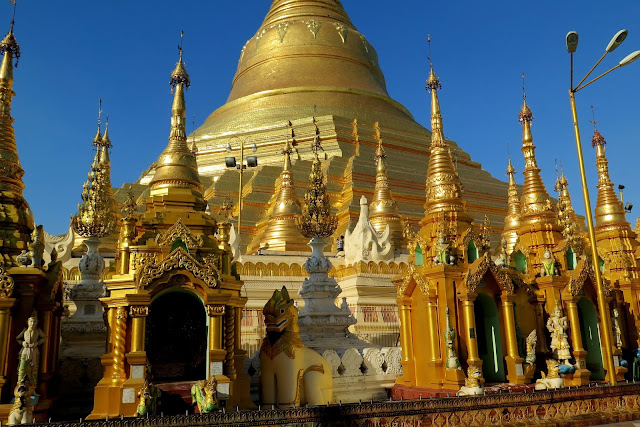

























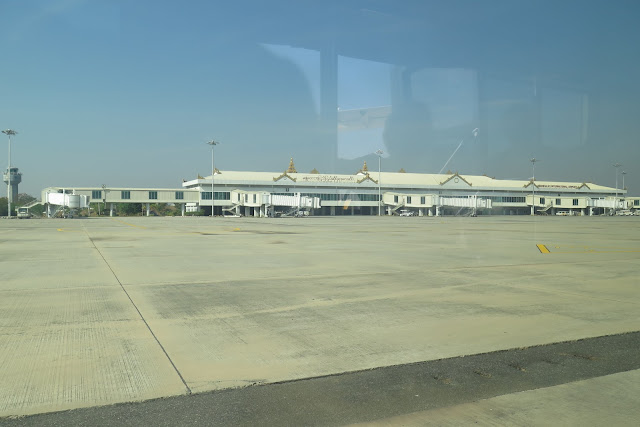

















































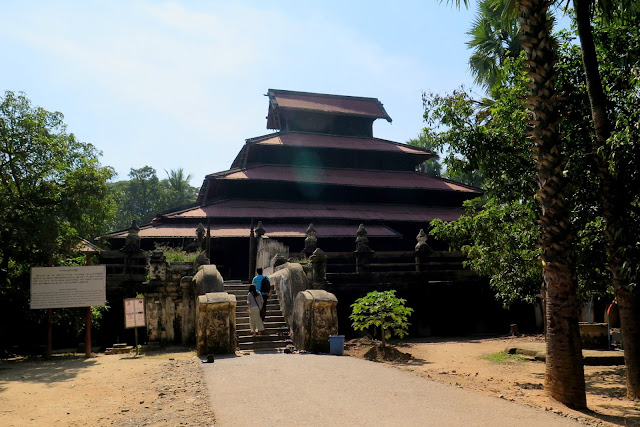













































































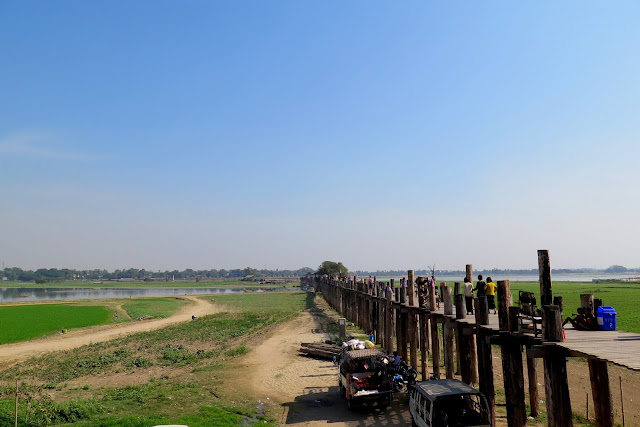



















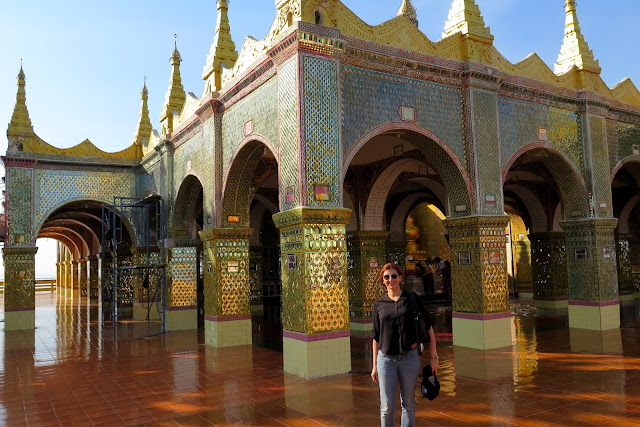










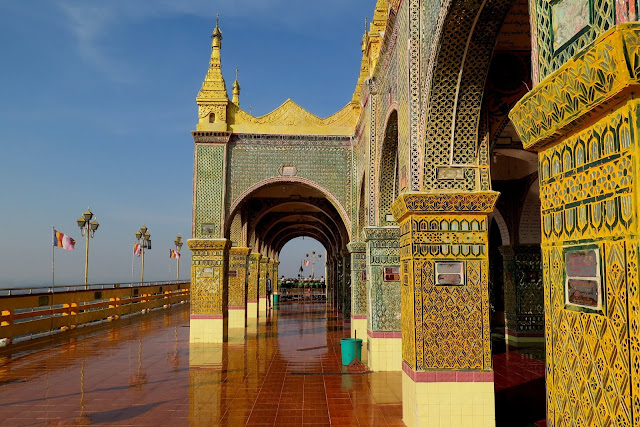




















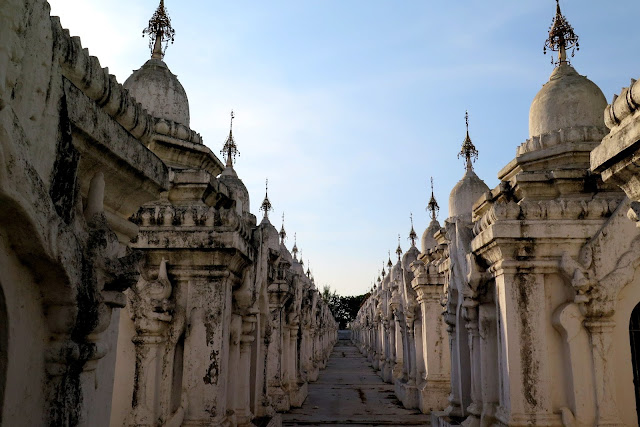













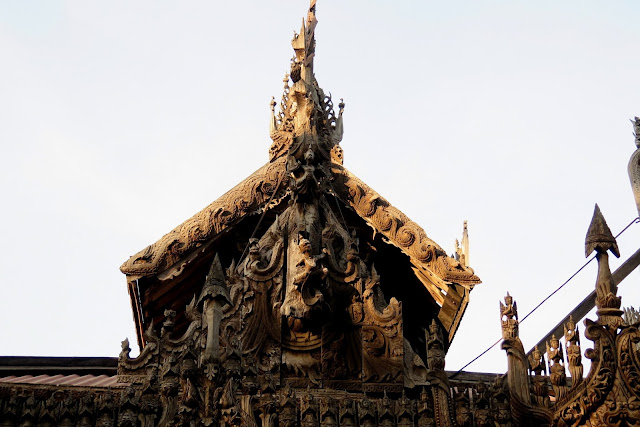











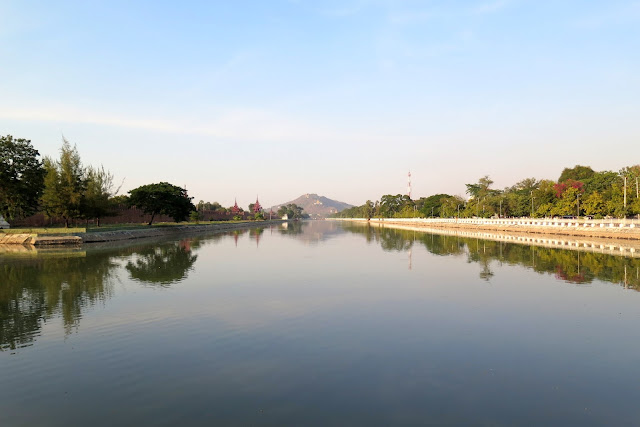














































































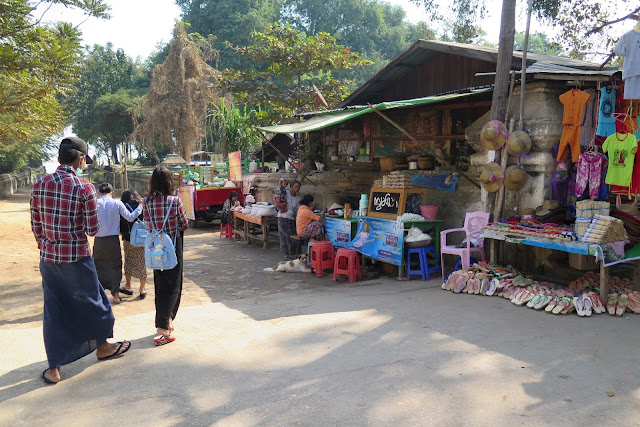





















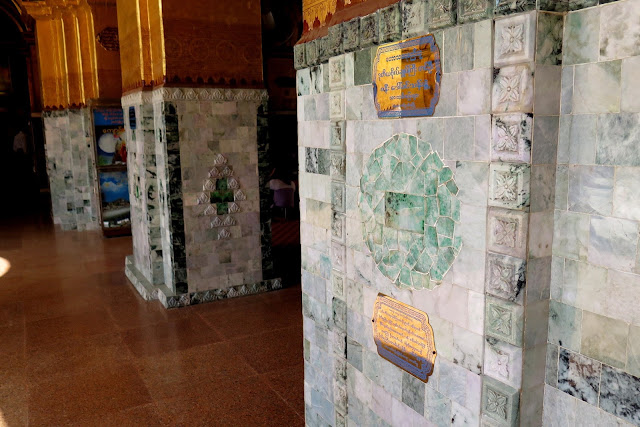



No comments:
Post a Comment